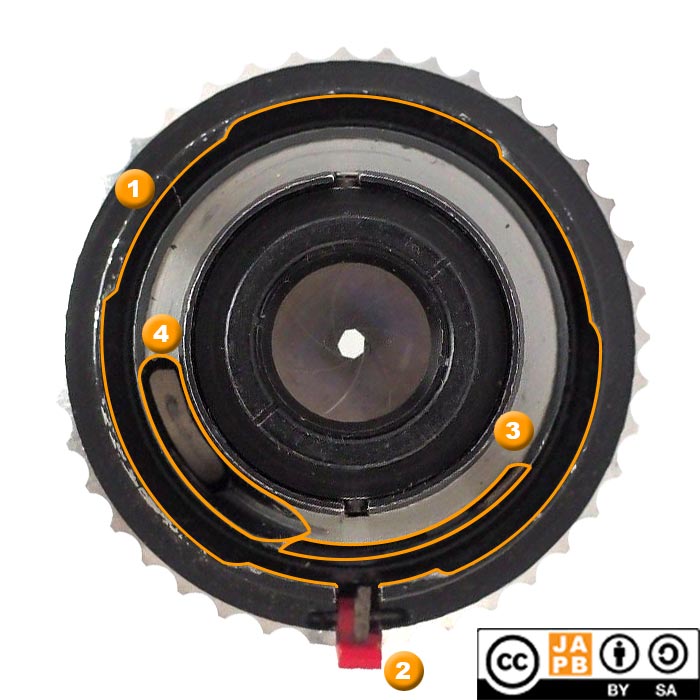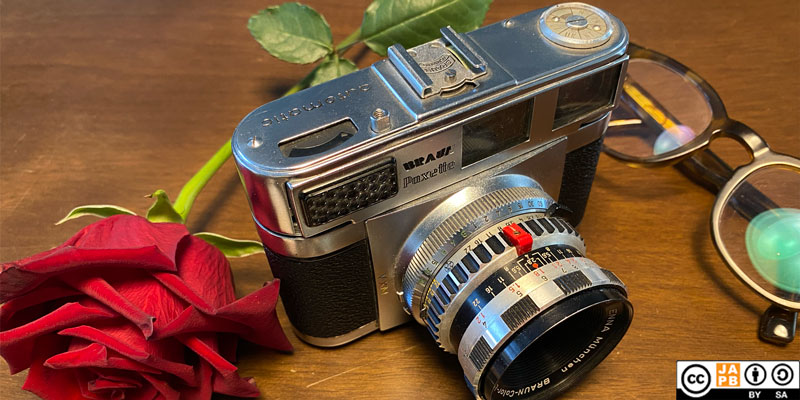Pekka Buttler, 02/2025
Executive summary
The SLK mount was a family of interchangeable lens mounts for 1950s and 60s West German rangefinder cameras manufactured by Bolta, Braun and King. The SLK is in some ways similar to the more well-known DKL mount. Please read on.
SLK mount specifications and identification:
Mount type: three-prong female bayonet (lens release on lens)
Flange focal distance: 44,4 mm
Film format: 36mm x 24mm (‘Full frame’)
Mount communication: One cam for indicating focusing distance (lens-to-camera). A lever to communicate aperture settings to lens (camera-to-lens)

Characteristics of lens mount:
[1] Three-pronged female bayonet with locking groove at 6:00
[2] Red lens release button (all BraunSLK and BoltaSLK lenses have the same, prominent red lens release button. With KingSLK lenses the button is more discreet)
[3] Aperture lever position.
[4] Rangefinder cam.
Note that the position of areas [3] and [4] are different (vis-a-vis the bayonet mount) on the KingSLK lenses)
History (and why you likely have not yet heard about the SLK mount)
Back in the 1950’s it was yet unclear which shutter technology – leaf shutters or focal plane shutters – would ultimately rule the field of professional and prosumer cameras. While both the German and Japanese photographic industry had introduced a number of new marvels based on focal plane shutters, none of the central companies manufacturing leaf shutters were yet ready to give up without a fight.
In the West-German context1, both Gauthier (manufacturers of Prontor leaf shutters) and Deckel (manufacturers of Compur leaf shutters) were not willing to give up without a fight. Both companies designed their own interchangeable lens mounts that integrated a leaf shutter in the camera-end of the lens mount. Gauthier’s solution is today known as the SLK bayonet (also sometimes referred to as the Prontor bayonet), and Deckel’s as the DKL bayonet (sometimes referred to as the Compur bayonet).
While the DKL mount was for a time reasonably successful, the same cannot be said for the SLK mount. While several interchangeable lens cameras were built to utilise the SLK mount (see below), these were not as successful as those using the competing DKL mount. Because the camera industry was at the same time making leaps-and-bound progress, the SLK-mount was a very short-lived affair (roughly 1956–1962).
Similarly to the DKL mount (which was not one mount as much as half a dozen similar but incompatible mounts), so too the SLK mount is not one mount, but three mutually incompatible mounts that share similar origins, design philosophy and some physical traits. As with the DKL mount, the incompatibilities were highly deliberate.
Whatever the designers back then might have been thinking, as a result there are three variants of the SLK mount: One for the Bolta Photavit cameras (subsequently BoltaSLK), another for the Braun Paxette Super III Automatic (BraunSLK) and a third for the King Regula IIIc/IIId/Super cameras (KingSLK)
SLK mount cameras & lenses

The following camera models were offering an SLK mount to be able to use interchangeable lenses. The list is likely complete:
Bolta
• Bolta Photavit 36 (introduced 1956, no light meter / uncoupled light meter2)
• Bolta Photavit 36 Automatic (introduced 1956, coupled light meter)
Braun
• Braun Paxette Super III Automatic
King
• King Regula IIIc (introduced 1956, no light meter)
• King Regula IIId (introduced 1956, uncoupled light meter)
• King Regula IIId automatic (introduced 1956, coupled light meter)
• King Regula Super (introduced 1959, uncoupled light meter)
• King Regula Super automatic (introduced 1959, coupled light meter)
While Braun only made one camera model to use the SLK mount, the Paxette Super III Automatic likely outsold the entire rest of SLK cameras.
The German optics companies Enna München (until 1956 Enna Werk München), ISCO Göttingen and Steinheil München produced a decent list of lenses for each of the three subfamilies of SLK systems.

This table has been collated combining public sources with brochures and samples that have been seen online. However, due to the rather short life and disappointing sales of the respective systems, many of these lenses are exceedingly rare (and I do not discount that some of them were never serially produced).
Adapting SLK mount lenses:
Besides getting an original German 1950s rangefinder to utilise the lens in its native environment, the possibilities of using this lens are very limited … unless you can channel your inner Gyro Gearloose.
The heart of the matter is that there seem to be no ready-made adapters available for the SLK lens mounts anywhere, likely due mostly to the rather lacklustre sales success of the SLK systems and resulting low number of SLK lenses out there.Therefore one would have to manufacture their own – either through some 3D designing&printing or by cannibalising an original camera.
SLK lenses are (again) similar to DKL lenses in that they lack an aperture control ring of their own (as aperture was controlled on the camera. This means that any successful adapting of SLK lenses will necessitate an adapter that interacts with the lens aperture control lever on the lens to facilitate aperture manipulation, but otherwise the adapter
Footnotes
- Similar experiments were done both in the Soviet Union and in Japan. In Japan Seikosha teamed up with Tokyo Kogaku to produce the successful line of Topcon UV cameras and lenses. See more in the JAPB company profile for Topcon ↩︎
- Early models of the Bolta Photavit did not include a light meter, later model included an uncoupled light meter. ↩︎